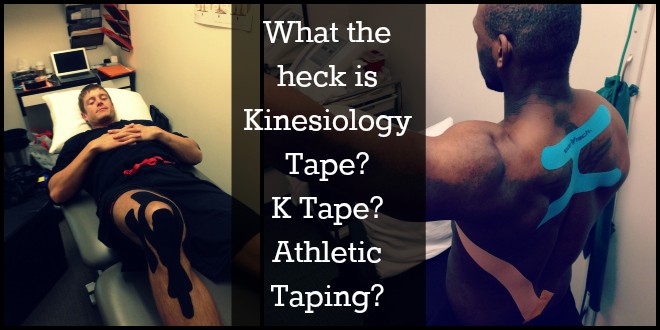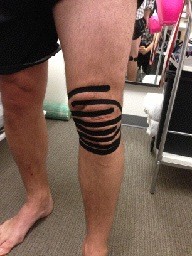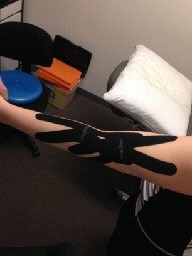What the heck is Kinesiology Tape? K Tape? Athletic Taping?

 [dropcap]Y[/dropcap]ou've
seen the emergent trend of athletes covered in intricate multicolored tape jobs all over their bodies. So what’s the deal with this tape?
[dropcap]Y[/dropcap]ou've
seen the emergent trend of athletes covered in intricate multicolored tape jobs all over their bodies. So what’s the deal with this tape?
It is an elastic athletic tape that has gained significant popularity in recent years in rehab medicine and athletics from the recreational athlete all the way to their professional idols. As both a physiotherapist and an athlete, I have had significant experience using it with my clients and on myself. I help teach for one of the major tape brands, have taken advanced courses with several of them and I regularly volunteer my taping skills at major sporting events. You'd think with all that I would be biased, but in reality I’m still a natural skeptic.
So this begs the question, what the heck is Kinesiology Tape? K Tape? Kin Tape? Athletic Taping?
Apparently there is a bunch of good clinical research about how the tape works and what it causes and how we see a 14% improvement in A) a 19% improvement in B) and blah blah blah. I’ll leave the scientific research to other PhD’s who want it cited in their next study. That stuff bores most of us. Here’s what I know: I use the tape for four major purposes and in my experience, if used properly, it WORKS!
4 Ways that Kin (Athletic) Tape can help you
1. Kin Tape helps you move
 The first thing the tape can be used for is to provide a mechanical advantage to tissue. This can reduce the load on injured tissue or reduce fatigue in a contracting muscle. If you strain your hamstring, I can tape from your glutes along your hamstring and down past your knee and the elastic energy of the tape will mimic the pulling pattern of that hamstring. Therefore, because the force from elastic energy is taking some of the load, less force needs to be generated by your hamstring to create the same amount of movement. The tape will also help prevent that hamstring from over-stretching: as that hamstring start to lengthen, the tape stretches - applying increasing tension - which resists that movement and causes a palpable cue to the athlete that their injured tissue is near the end of its tolerable length. In my experience, this works great for recent muscle strains, for lower backs in competitions like CrossFit where muscular endurance is a factor, for relieving stressed postural muscles and for unloading common tendonopathies like Achilles tendon issues.
The first thing the tape can be used for is to provide a mechanical advantage to tissue. This can reduce the load on injured tissue or reduce fatigue in a contracting muscle. If you strain your hamstring, I can tape from your glutes along your hamstring and down past your knee and the elastic energy of the tape will mimic the pulling pattern of that hamstring. Therefore, because the force from elastic energy is taking some of the load, less force needs to be generated by your hamstring to create the same amount of movement. The tape will also help prevent that hamstring from over-stretching: as that hamstring start to lengthen, the tape stretches - applying increasing tension - which resists that movement and causes a palpable cue to the athlete that their injured tissue is near the end of its tolerable length. In my experience, this works great for recent muscle strains, for lower backs in competitions like CrossFit where muscular endurance is a factor, for relieving stressed postural muscles and for unloading common tendonopathies like Achilles tendon issues.2. Kin Tape speeds the healing process
 The second use for kin tape is for lymphatic drainage and reducing swelling. In my experience, there is no other product or modality on the market that works as well as this. So ditch the physio who just wants to ultrasound your visibly swollen joint and find one who will tape it properly. (If you want to get better faster that is!) These are the web-like tape patterns you see on people. The tape is cut with one solid end feeding into usually four narrow finger-like projections, and is placed over the skin often in a cross hatching almost argyle like pattern. I don't need research to tell me if or how this works. The results are clearly evident to the naked eye. If I put a tape job on a swollen joint or a heavily bruised swollen tissue, two days later when I remove it, I can clearly see that the bruising and swelling under where the tape was placed is gone or at least noticeably reduced (see the photo on the right). Apparently the tape creates a lifting effect on the skin which reduces pressure under the tape and reduces the congestion caused by the inflammation. This allows for more blood flow and lymphatic activity to occur under the tape, ultimately improving the body’s own ability to better deal with the inflammation and swelling. Increased fluid dynamics also applies to healing tissue, allowing for faster healing by bringing good stuff like nutrients and oxygen to the tissue and by flushing away the bad stuff like waste products and CO2. Think of it like groceries in, garbage out!
The second use for kin tape is for lymphatic drainage and reducing swelling. In my experience, there is no other product or modality on the market that works as well as this. So ditch the physio who just wants to ultrasound your visibly swollen joint and find one who will tape it properly. (If you want to get better faster that is!) These are the web-like tape patterns you see on people. The tape is cut with one solid end feeding into usually four narrow finger-like projections, and is placed over the skin often in a cross hatching almost argyle like pattern. I don't need research to tell me if or how this works. The results are clearly evident to the naked eye. If I put a tape job on a swollen joint or a heavily bruised swollen tissue, two days later when I remove it, I can clearly see that the bruising and swelling under where the tape was placed is gone or at least noticeably reduced (see the photo on the right). Apparently the tape creates a lifting effect on the skin which reduces pressure under the tape and reduces the congestion caused by the inflammation. This allows for more blood flow and lymphatic activity to occur under the tape, ultimately improving the body’s own ability to better deal with the inflammation and swelling. Increased fluid dynamics also applies to healing tissue, allowing for faster healing by bringing good stuff like nutrients and oxygen to the tissue and by flushing away the bad stuff like waste products and CO2. Think of it like groceries in, garbage out!3. Kin Tape can offer support to the joints
 The third use for the tape is to support and improve joint mechanics. These are the knee and shoulder tape jobs you see on a lot of athletes. I’m still a little skeptical on the actual mechanism of this, but the theory I am supposed to believe is that applying tape over an area increases the skin sensation signal received by the brain. Ultimately the brain sends more signal back down to that area and to the muscles under that tape, normalizing the tone and function of those muscles. I don’t know if I buy that or not, but for some reason it works. Patients have come into my clinic with significant shoulder pain every time they move their arm, I've taped it, and they come back a few days later and high-five me with the same arm, telling me they slept better, work was easier, and they can move their shoulder without pain. However it works, it seems to allow joints to work a bit better and allow for improved function especially after an injury. That’s enough research for me.
The third use for the tape is to support and improve joint mechanics. These are the knee and shoulder tape jobs you see on a lot of athletes. I’m still a little skeptical on the actual mechanism of this, but the theory I am supposed to believe is that applying tape over an area increases the skin sensation signal received by the brain. Ultimately the brain sends more signal back down to that area and to the muscles under that tape, normalizing the tone and function of those muscles. I don’t know if I buy that or not, but for some reason it works. Patients have come into my clinic with significant shoulder pain every time they move their arm, I've taped it, and they come back a few days later and high-five me with the same arm, telling me they slept better, work was easier, and they can move their shoulder without pain. However it works, it seems to allow joints to work a bit better and allow for improved function especially after an injury. That’s enough research for me.4. Kin Tape will make it hurt less
 The last use for the tape is simply to reduce pain. In addition to the mechanisms discussed earlier - preventing excessive stretching of an injured tissue, reducing muscle fatigue, reducing swelling and inflammation, improving joint movement mechanics and normalizing tissue tone which in theory can all reduce pain - the tape applied by itself can help to reduce pain (or at least the perception of pain). This is likely because of something called “Gating Theory”. Gating Theory is the idea that the brain can only receive a limited number of signals at a time from an area of the body. By tensioning the skin with tape the brain receives the signal from the skin receptors, instead of pain signals from the damaged tissue. More skin signals to the brain means less pain signals can get in and be felt. Ultimately, the perception of pain is reduced.
The last use for the tape is simply to reduce pain. In addition to the mechanisms discussed earlier - preventing excessive stretching of an injured tissue, reducing muscle fatigue, reducing swelling and inflammation, improving joint movement mechanics and normalizing tissue tone which in theory can all reduce pain - the tape applied by itself can help to reduce pain (or at least the perception of pain). This is likely because of something called “Gating Theory”. Gating Theory is the idea that the brain can only receive a limited number of signals at a time from an area of the body. By tensioning the skin with tape the brain receives the signal from the skin receptors, instead of pain signals from the damaged tissue. More skin signals to the brain means less pain signals can get in and be felt. Ultimately, the perception of pain is reduced.Pre-cut Kin Tape Vs Kin Tape on a Roll
Over the last month or so, I've taken the opportunity to experiment with Spidertech kin tape. What makes Spidertech tape different is they specialize in pre-cut tape applications. They offer more than 15 different pre-cut applications for various areas of the body and different desired effects. As somebody who has had a lot of practice and is pretty proficient at taping with a traditional roll of kin tape, using the pre-cut applications was almost more of a nuisance than a benefit. That said, for somebody with limited taping experience who only needs to buy tape for one specific problem area, I’d highly recommend trying out the Spidertech pre-cut kinesiology tape .

The pros of Spidertech Kinesiology Tape
- Usability: Some of the Spidertech pre-cut pieces of tape are easier and faster to apply than measuring and cutting tape off of a roll - as long as you pay attention to detail. (Especially the upper back postural tape job, the lymphatic drainage strips, and the pre-cut stars.)
- Packaging: The packaging and marketing of the tape grabs your attention. Spidertech tape come in large packs, individual packaging, and is very visually appealing for retailers.
- Wow Factor: Some of the intricate pre-cut tape jobs like the knee and the shoulder are incredibly intricate and look pretty impressive once they are on.
- Large Skin Surface Coverage: Referring to the knee and the shoulder again, the pre-cut applications provide a lot of skin coverage. A large skin contact will increase the amount of skin sensation heading to the brain which will help to reduce the amount of pain signal received by the brain.
- Go Canada: Spidertech tape is made in Canada. Buying Spidertech tape supports our local businesses.
The Cons of Spidertech Kinesiology Tape
- Complicated Applications: Some of the Spidertech pre-cut pieces are overly complicated and take a long time to apply. In my opinion they don’t really add any added value in terms of support. (This is more of a reason for practitioners who have limited time and need to tape people quickly.)
- Cost: Having to pay for right and left joints independently is inconvenient as a practitioner.
- Lifespan: The glue does not last as long as some other brands of kin tape on the market.
- Environment: There is a lot of excess packaging that ends up in the garbage.
In summary, my thoughts on Kin Tape
I've had great results using tape in my practice and I strongly believe in the benefits it can provide. I’m still a skeptic on how and why the tape works with certain applications, but ultimately my job is to get people healthy and performing at their best as fast as possible. Kinesiology tape is an effective tool to help reach that goal. There are minimal risks or side effects if the tape is applied properly, so find somebody who knows what they are doing or educate yourself and give it a try. Happy taping!
[divider]
 Author Bio: Drew Teskey Bkin Hon, MPT, AFCI
Author Bio: Drew Teskey Bkin Hon, MPT, AFCI
Physiotherapist @ Studeo55
Drew is the resident physiotherapist at Ntegrated Health @ Studeo55, a multidisciplinary clinic located within Studeo55, a 16,000 square foot training facility in Downtown Vancouver. Drew’s physiotherapy practice is a part of Ntegrated Health’s highly collaborative approach to rehab medicine emphasizing strong communication and interaction amongst its team. The team consists of a physiotherapist, registered massage therapist, chiropractor, holistic nutritionist, trainers and coaches. What makes Ntegrated Health @ Studeo55 so unique is that every practitioner on the team not only brings an exceptional individual skill set and impressive credentials, but is also an athlete themselves and practices what they preach. It’s a clinic where clients are treated like athletes to bring out their full physical potential. Like us on Facebook to see what we are up to these days.
[divider style="solid" top="20" bottom="20"]




































































































